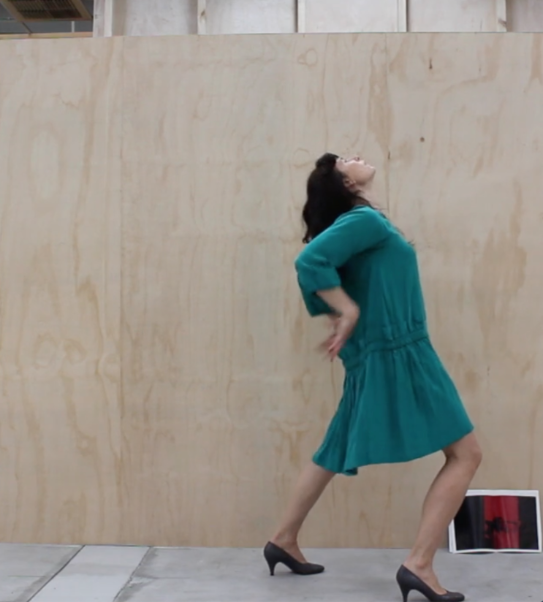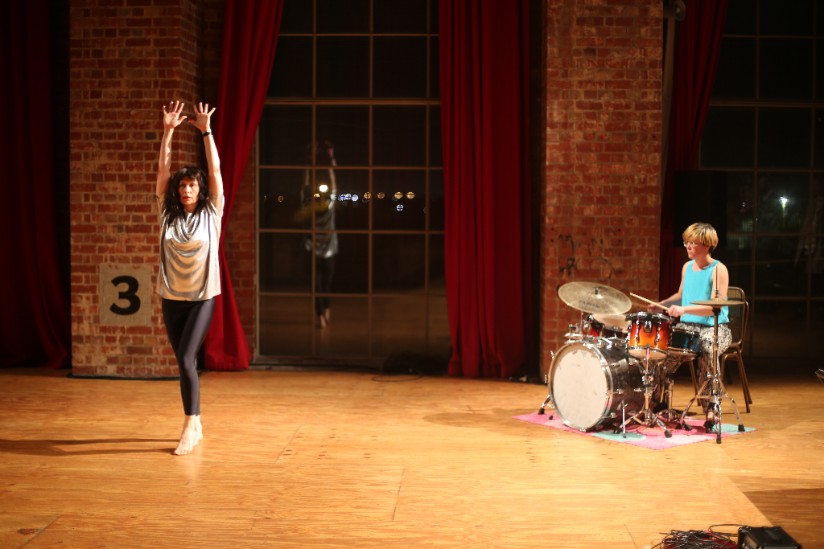Deanne Butterworth is a highly acclaimed Melbourne based dancer and choreographer. Her interests lie in the transfer of information and ideas from one body to another, the creation of energies, systems, languages and understanding developed in isolation and within groups of people. Her work is often responsive to the space in which it is shown and can involve still images, sound, music, text and video. Her works have taken place in a variety of settings including traditional performance spaces as well as galleries and outdoors.
Over a twenty year period Deanne has worked with many artists and choreographers including Phillip Adams Balletlab, Tim Darbyshire, Maria Hassabi, Rebecca Jensen, Shelley Lasica, Shian Law, Jo Lloyd, Sandra Parker, Lee Serle and Brooke Stamp amongst others. Some of her own works include: Dual Reperage in Threes, Dancehouse for Dance Massive (2011); Twinships, West Space (2012); Doublage, Arts House for Dance Massive, (2013); Siteless Now, NGV (2014), Regarding Yesterday (with Adva Zakai) at Slopes Gallery (2014); How Choreography Works (with Shelley Lasica and Jo Lloyd) at West Space and later at the Art Gallery of New South Wales for the Biennale of Sydney (2016); All Our Dreams Come True (with Jo Lloyd) at Bus Projects (2016); Two Parts of Easy Action, The Substation (2016); The Interlude, Spring 1883, (2016).
She has collaborated with or performed in the work of many visual artists including Belle Bassin and Justene Williams (both at Heide MOMA, 2016), in the work of Damiano Bertoli (Margaret Lawrence Gallery, 2016), David Rosetzky (2007), and Fiona MacDonald (2001). In 2012 she collaborated with artist Linda Tegg to host a performance at a petrol station in inner city Collingwood.
In 2015 Deanne participated in an interdisciplinary notation workshop organised by Hannah Mathews and in 2016 was artist-in-residence at the Boyd Studio 1 funded through City of Melbourne Creative Spaces program. In 2017 she worked with Rebecca Jensen and Shian Law in works which premiere for Dance Massive 2017 and with Jo Lloyd in the new work, Overture for Four.
Deanne studied at Western Australian Academy of Performing Arts (BA dance, 1993) and Victoria University (2011).
Gertrude Contemporary's Communications and Development Manager, Anador Walsh had the pleasure of interviewing Deanne on her practice.
Anador Walsh: When did you first become interested in movement and its potential? Was it at a young age, in a formal context? Or was it something more natural and intuitive?
Deanne Butterworth: It was at the age of four that I started dancing and I haven’t ever really stopped doing it. Moving, watching others and learning more about the world through dancing. Because I’ve been doing it for such a long time, there is something natural about it - I mean it feels like a natural thing for me to do, but not in the way that I want to dance all the time - maybe it’s about being practiced in and continuously immersed in a non-verbal physical language and over time behaving differently because of that. I tend to stumble over verbal language sometimes and circumvent a topic, which is maybe how I behave when I move as well, but maybe the moving is clearer than the talking.
Your practice is very much grounded in responding to the possibilities of space and in the transformation of space. As a Gertrude Studio Artist, how would you seek to transform your studio space: through dance, physical intervention or other means?
The day I moved in I brought a table, a chair and a mobile speaker so I’ve hardly transformed the space, yet. Having said that, I feel that a lot of my recent practice and performance works ask questions of and about the space I am in, or where a proposed work might take place. In the past I have become quite pedantic about the history of a space, feeling like a want to find out more about it before I start doing something. With the Gertrude Studio I came in and started working, working with a movement practice and using that to explore the space. The space has a very particular liveliness because of the openness and the proximity to other artists. It’s also a vastly different space to other studios I have worked in. There are sounds from other people, the sounds of the building and of me working in there. It’s as if there is a heightened awareness of what I produce while being there (sound and energy), how that’s heard by others and what they might imagine it is. It produces a particular kind of self-consciousness. At the moment I feel that the space is in a process of transforming me.
Your work transcends dance and extends itself into a space that encompasses video, image, sound, music and text. How do you navigate the melding of these mediums in your practice? Is it a process of response, such as: an image evokes a movement, or a movement occurs in response to a sound? Or is it something different entirely?
It’s probably not quite as streamlined as that and more a combination of things. Sometimes the different things that are involved are like a puzzle that doesn’t quite fit together. I never want to be too literal about things and say exactly what the thing is. I’m still sort of in awe of the potential of the body while moving and what it can do - how it can evoke multiple thoughts and ideas in the eyes of a viewer. I often work with multiple images in the beginning of a new work, but they’re not always things I will have in the studio to show someone - they might be more imaginative images that form as I do something, or might be carried through from one work to the next. In some ways, the use of these different mediums came out of a desire to show something about the process of making work and what interested me . So I might use video, sound, music, text and other things in the process of making work and then I began to reveal these so they became a part of it, sometimes actually becoming the work. It might be something about revealing and concealing, showing a sense of vulnerability and also being okay with working with things that I’m really not technically skilled in.
We have also interviewed Studio Artist Alumni Damiano Bertoli in this incarnation of the Gertrude Newsletter. You collaborated with Damiano in 2016 on Continuous Moment: Big Foot’s Studio. This collaboration is a prime example of your melding mediums in your work. Can you elaborate on this - how did this collaboration function?
Yes! I performed in Damiano’s work for a one-off performance at Margaret Lawrence Gallery and was a merging of two characters - ‘The Curtains’ and ‘The Two Dogs’. I don’t think of this as a collaboration though - it was certainly Damiano’s work and I was a participant in it. I really loved the way he directed and gathered people together for this situation - there were perhaps about eight people ready and willing to contribute to this slightly mad performance. We each had our own specific roles and function, and hadn’t previously worked together and certainly hadn’t rehearsed together. What happened was a result of what Damiano had set up - conversations we had, information he had given us, our knowledge of the exhibition and his work and our own histories. For me there was a sense of both fear and excitement going into this. Damiano was excellent in his role as the performing director and very comfortable with a particular looseness and unfolding of events over time, both in relation to his exhibition and to the audience. On reflection, he had such immense trust in this thing working, and there was certainly an expectation and buzz from the viewers that something brilliant was going to happen which I find fascinating. I do remember conversations we had about movements and how they might potentially be ‘read’ by the viewer, which revealed particular things about our individual histories.
Transformation is a consistent theme that spans your practice. Your work with Shelley Lasica and Jo Lloyd particularly spring to mind when speaking of your more transformative pieces. Can you speak a bit on your collaboration with these artists, and how that collaboration has allowed for transformation – be that of the audience or the space in which you performed?
I think I should be clear about the differences between working with colleagues to create work together, collaboration, authorship, and working in the works of other artists. Shelley, Jo, and I created a work together in 2015 called ‘How Choreography Works’, shown at West Space and I would call this the only ‘collaborative’ work we have done together. Jo and I have made 3 works together since about 2002. Prior to this I had performed in Shelley’s works since 1996 and in the work of Jo since 1999. In the works by Shelley and Jo I was a contributor, experimenting, and offering a lot of my own thoughts, ideas, and questions through speaking and moving in the development process in their work. However I wouldn’t ever call myself a collaborator here, more a contributor - I would still credit Jo and Shelley with the authorship of their works I performed in.
When we have created work together, transformation and change have been examined. Questioning how things happen, where information comes from and how interests develop, how a physical language is developed, how one prepares for a performance and how that preparation affects what happens. My experience of working in their works has over time transformed my practice and perhaps their practice - in some ways that bleed is inevitable and can lead to a rebellion against what is known and an urgency for change, while reflecting upon a history.
Finally, space aside, what else inspires you to move and make new work?
It’s all in a process of transforming, as I try to work out how the Gertrude Contemporary studio is altering my practice. I’m a bit stuck on the '80s work ‘The Five Sisters’ by Guy de Cointet at the moment. I’ve also been thinking of something to so with 'a space within a space within a space ' which has something to do with the Gertrude studios' setup. I’m also spending a bit of time looking at the past - early influences that I rejected, but am interested in revisiting. But seriously, I still trip out over the potential of the moving body - watching someone breathe can be pretty fascinating - so moving will be an obsession for quite some time.



